Last Updated on January 13, 2024 by Greg Gillson
Is the Celestron Nature DX ED 8×42 binocular any good for bird watching? My personal opinion, after buying and using them for some time is yes. These binoculars are an excellent introductory pair of birding binoculars.
The Celestron Nature DX ED 8×42 is a great choice for a full-sized entry-level birding binocular.
These budget-friendly binoculars have good optics with ED glass and BaK-4 prisms that combine a bright and sharp image with excellent contrast and rich color. They are sealed to be both waterproof and fog proof. They have a wider than average field of view for easily spotting flying birds as you raise your binoculars to your eyes.
I recommend them as the best birding binoculars under $200.
A recent binocular review by Cornell’s All About Birds (source) lists the Celestron Nature DX ED 8×42 as one of the top 3 budget binoculars for bird watching.
They are not perfect, though. Nor, for this price, should they be. Please read on.
 |
| Celestron Nature DX ED 8×42 |
Binocular specs (the numbers that matter)
| Model Size |
Price MSRP |
FOV @ 1000 yds |
Close Focus |
Exit Pupil |
Eye Relief |
Weight |
|---|---|---|---|---|---|---|
| Celestron Nature DX ED 8×42 |
$177.95 | 393 ft | 6.5 ft | 5.25 mm | 17.8 mm | 24.9 oz |
The table above shows the most important specs when it comes to bird watching binoculars. Bird watching requires several optical parameters that don’t matter as much for hunting or general wildlife viewing. These numbers can be a bit intimidating, but I explain, below.
The 8x magnification is best for general bird watching. Combined with the 42 mm objective lens, this is ideal. The 42 lens size divided by the 8x magnification is the exit pupil of 5.25 mm. Anything over 5.0 allows your pupils to receive a bright image in bright or dim light.
The field of view of 393 feet at 1000 yards describes how much scenery, side-to-side, your binoculars take in. If there was a fenceline perpendicular to you 1000 yards away, you could see 393 feet of it through these binoculars. That is generous. It isn’t the absolute best (440′), but it is far better than those with a narrow field of view (330′).
If you enjoy watching butterflies at your feet, or hummingbirds at the window feeder from inside your home, you will appreciate the very good close focus distance of only 6.5 feet. Many binoculars only close focus to 8 or 9 feet. The very best get down to 5 feet. So this is very close to the best! If there is a bird hopping very close to you in the brush, you won’t have to back up to see it!
Eyeglass wearers will appreciate the long 17.8 mm of eye relief. Longer is better, up to 19 or 20 millimeters. Anything less than 15.5 mm will cause vignetting, and you won’t be able to see the whole field of view described above. Less than 15 mm and you can’t really use eyeglasses with binoculars. So this is an important specification.
Full-sized binoculars weigh from 20-30 ounces. These, at 24.9 ounces are “middle of the road,” as far as weight, you might say.
The Celestron manufacturer’s page is here here.
Construction of the Celestron Nature DX ED
Optics
To save money, most binoculars under $200 skimp on the expensive glass and coatings. But not these. They have every optical glass, prism, and coatings of the best binoculars.
The lenses use extra low-dispersion (ED) glass. These help keep all the colors together and crisp and sharp. They are fully multicoated to reduce reflections and give a bright image. That means that as much of the light as possible that falls on the objective lens passes through the binoculars to reach your eyes. Even in dim light you’ll receive a bright colorful image.
The prisms are the best BaK-4 type. They are phase coated to reduce color fringing, which is when the different colors of light split into a rainbow. And the mirror surfaces of the prisms have dielectric coatings. Cheaper prisms may have a mirror of silver.
Even if you don’t understand what all these terms mean, make sure that your binocular specification page says: ED glass, fully multicoated, BaK-4, phase-coated, and dielectric coating. Then you’ll know you’re getting the best possible chance for great optics. Don’t skip the ED glass still available with the older less-expensive model.
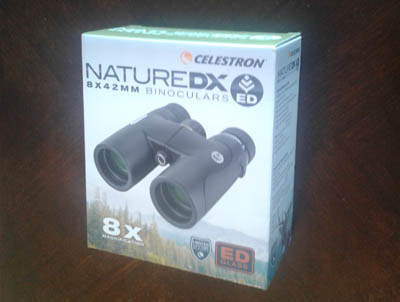 |
| It arrived! |
Chassis
Full-sized binoculars with big glass are heavy. Rugged binoculars are made of metal, such as aluminum or magnesium. Light-weight binoculars such as these Celestrons are made with thermoplastic polycarbonate resin, often reinforced with fiberglass. They are easy to mold during manufacture and are strong and resist breaking once cool.
Added protection is in the form of a rubber armor over the body. It is of the harder rubber, rather than the tacky rubber that feels like leather. To make up for the slipperiness of the hard rubber, the hand grips are textured, which I think is a nice touch.
These are o-ring sealed to make them waterproof (usually for cheaper binoculars to a depth of 3 feet for 10 minutes). You’ll be able to take these out in wet weather without worry about ruining them or water getting inside.
And they are nitrogen-purged. The air inside the binoculars has all been replaced with nitrogen gas. Why? Air contains water vapor. Water vapor inside binoculars can condense when going from snowy cold outside weather to warm inside or car and back. That won’t happen with these binoculars! Such conditions can cause condensation on the outside of the lenses that you wipe off with lens cloth. But they won’t ever fog up on the inside. They are fog proof.
To take advantage of the generous eye relief, these binoculars have twist up eye cups. If you wear eyeglasses, then twist the eyecups down. If you don’t wear eyeglasses, then twist the eye cups up and out. There are multiple stops on the eye cups to allow you to find the best distance between your eyes and the binocular optical lenses for best view. If not correct, you’ll get black circles or crescents in your view. Your eyes need to then be closer or farther back, using the adjustable eye cups.
The bridge between the two binocular barrels hinge to close or open. They allow you to combine both barrels into a seamless view with your eyes. Since eyes vary in how far apart they are (interpupillary distance), these binoculars adjust from 56-74 mm. These allow for narrow or wide-set eyes to use these binoculars correctly. They should be ample for most adults. But younger children may have eyes too close together and they won’t be able to see an image through the binocular with both eyes at the same time.
I’ve never used it on any binocular, but these do have a screw for a tripod mount. That is impressive for these budget binoculars.
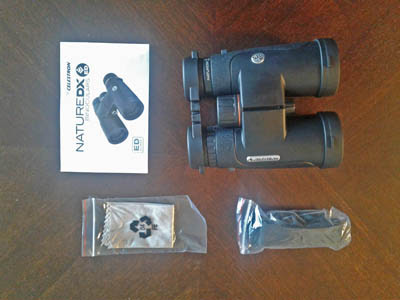 |
| Binocular, user’s guide, lens cloth, neck strap. |
My review
I compared these Celestron Nature DX ED binoculars with my same sized Nikon Monarch 7 binoculars. The Monarchs are 3x more expensive, but nowhere near the top-of-the-line.
[See my review of the Nikon Monarch 7 8×42 binoculars, the best birding binoculars under $500.]
My wife, Marlene, was with me on a trip where we spent much time comparing them. She isn’t as dedicated to bird watching as I am. She doesn’t have much experience with binoculars, either, especially good ones. So I used her as a “beginner binocular user” to get her impressions.
Image
First of all, I was totally impressed with the Celestron’s colorful and contrasting image.
It appeared to me that perhaps the greens and yellows were more brilliant in the Celestron than in the Nikons. And the contrast between dark and light appeared greater. This may have to do with the coatings on the glass reducing the blue hue to create more contrast. I didn’t think it altered the hue too much toward the yellow. Bird watchers want accurate color. I thought these were a bit warm, but still accurate.
Marlene didn’t notice any difference between the image switching from the Celestron to the Nikon. I didn’t tell her about the slight color difference I saw. She often liked the image produced by the Celestron “better” but couldn’t tell me why. But then I noticed she was wearing photochromatic sunglasses!
Marlene noticed that with both the Celestrons and the Nikons it was much easier to find birds. That’s due to the wide field of view. No wonder, her usual binoculars were a cheap pair of 7-15x 25. They really are like looking through a straw. They have only a 282 foot field of view at 1000 yards–and much less when zoomed to 15x. The lenses are plastic. The view is cloudy. It’s really a toy. I don’t know why I haven’t gotten her anything better. Well, now she’ll have these Celestron Natures! (Am I 3 months early on an anniversary gift? Or 9 months late?)
Focus knob
One feature where Marlene and I differed was on the focus knob. First of all, the Celestron Nature worked backwards from my Nikon Monarchs! Clockwise from my view to focus on closer objects. It took a bit of getting used to. Then, it took 2 complete turns to go from close range to infinity. Most binoculars take maybe 1-1/4 turns.
This means two things. The bird may fly away in the longer time it takes to readjust the focus of the Celestron, if the new bird isn’t near the same distance as the previous focal point. I didn’t like that.
However, Marlene noted that this slow focal adjustment allows you to get the bird in focus more perfectly.
Lens caps and rain-guard
I’ve never been a fan of lens caps. Binoculars should be “bare” and ready to look through at a moment’s notice! I don’t want to miss a bird because I’m fiddling with the lens caps.
Having lived most of my life in Oregon, however, I do appreciate that the rain-guard might be a good idea. They could also keep dust and grime from falling onto the lenses.
But what I found was that the rain-guard ended up tangled as the neck strap twisted. I think I put the rain-guard on correctly–there were no directions. But for this review I wanted to install everything.
Perhaps because the binoculars are new, the lens caps wanted to bounce up and cover the objective lenses. This was especially noticeable when looking upward to any degree. Perhaps with more use they’ll be less stiff and stay out of the way.
But do you really want them? If you want protection while traveling or not in use, there is a soft case.
Twist-up eye cups
I think the eye cups are the weakest point of the Celestrons. The eye cups seem very fragile and feel like very thin plastic. Those eye cups are the most likely to be broken if the binocular is dropped, hit, or treated roughly.
The eye cups twist too easily and loosely in and out. They turn with the slightest touch. They also have some loose play to their settings. I don’t often notice these things as wearing eyeglasses I always have the eyecups pushed all the way in.
Image softness at edge
While the center of the image is sharp and crisp and colorful, I noticed that softening of focus starts just over half way from center to edge, maybe at 60% of the view. This is where the low price shows.
Most users will not notice it because you center the binoculars over the exact spot of interest. But focus on a distant sign where you can barely read the letters. Then move the binoculars so you are looking at the sign near the edge of the binocular view. Then you can see that these aren’t crisp edge-to-edge.
The reason it is not obvious in use is that these binoculars have a wide field of view. Your own eyes are worse. The actual part of your vision that is in focus is no larger then a quarter coin held at arm’s length!
Chromatic aberration
I had a a hard time finding any chromatic aberration. The ED glass eliminated nearly all of it. Finally, I looked at the sun shining off a metal roof against a shaded tree, looking into the sun.
The brightly lit edge of the roof gave a yellow-green fringe at the top edge of the binocular image. Moving the roof edge to the bottom of the binocular image I saw a faint pinkish fringe. It was masked somewhat by the soft focus.
I couldn’t notice any color fringing on thin dark branches or electric lines against a bright sky, though. Very good.
Field of view
These binoculars have a fairly wide field of view. At 393 feet at 1000 yards they are at the low end of the wide field of view. Or, they could be considered to be at the very high end of the average field of view. Regardless, this is ample. Looking through the binoculars you will notice the expansive view.
Balance and feel
These binoculars are well-balanced and easy to use.
They are 2 ounces heavier than the Nikon Monarchs. But I can’t really tell the difference, just holding them.
One thing that I do notice, however, is the low profile of the bridge. This causes the focusing knob to be lower down between the eyepieces.
As your forefingers arch over the barrels they have to reach a bit farther to the focusing knob. That means you adjust the knob more with the tips of your fingers rather than the pads. With the extra turning this knob needs to focus, it is not as comfortable as it could be. That could make turning the focusing knob with gloved fingers more awkward.
Neck strap
The neck strap is surprisingly nice for such low priced binoculars. The neck strap is flat and about 1 inch wide. It is woven, like cloth, but I suspect it is made with strong nylon threads. It is comfortable and soft.
Still, you may want to eventually invest in a wide padded neck strap for long days in the field.
Diopter adjustment
The diopter adjustment is a ring at the right eyepiece, as typical for most binoculars. It doesn’t lock. But it is stiff enough that it will not move accidentally. It is marked only with a (- 0 +). You need to remember the adjustment. Unless sharing binoculars, though, you will set it once and forget it.
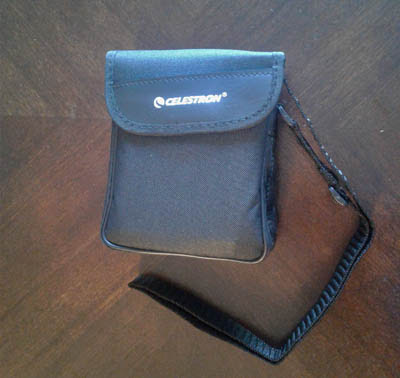 |
| Carrying case |
Carrying case
The Celestron Nature DX ED has a soft carrying case. It is adequate. With the rain-guard and the lens caps and the neck strap wrapped all around, it barely fits. But it does fit. It has a Velcro flap and a single pocket suitable for the provided lens cloth. It has a nice heavy woven strap, too. I rarely ever use a carrying case.
Similar species (binocular comparisons)
In an earlier article I compared birding binoculars under $200 (read it here). Here is a summary of the best of what I found.
Celestron Nature DX ED 8×42 vs Celestron Nature DX 8×42
The older version of this binocular is still in production. It is $30 less as far as the manufacturer’s suggested retail price. However, it may be found for near $100 online.
Is it really worth it to have ED glass? Oh yes. That ED glass cuts chromatic aberrations giving a clearer, sharper, and more colorful image. In fact, I had a very hard time finding any chromatic aberrations on the ED version, and then only on the very edge of the field of view.
The ED glass isn’t the only difference.
The eyepieces were redesigned on the newer ED version. That increased the FOV from 388 feet to 393 feet at 1000 yards.
It also improved the eye relief for eyeglass wearers, from 17.5 to 17.8 mm. The improvements aren’t much. But they were improvements, not just changes to ED glass lenses.
The newer version is 2 ounces heavier, too, showing it was a redesign, not just a lens replacement.
When you are comparison shopping, make sure you buy the Nature DX ED.
Celestron Nature DX ED 8×42 vs Vortex Crossfire HD 8×42
The specs for the Vortex Crossfire HD are nearly the same as for the Celestron. The eye relief isn’t quite as good for eyeglass wearers.
The main difference is the Celestron has the superior ED glass so that the image is crisp, sharp, bright, and colorful. These Vortex would have been a strong competitor with the old Nature DX, but the new Nature DX ED have superior optics.
Celestron Nature DX ED 8×42 vs Carson VP 8×42
Like the Vortex Crossfire HD, these have specs very similar to the older Celestron Nature DX model.
But the new Celestron Nature DX ED has slightly longer eye relief, so better for eyeglass wearers.
However, the biggest difference is that the Nature DX ED has the superior ED glass for an image that is brighter, sharper, and more colorful.
Celestron Nature DX ED 8×42 vs Wingspan SkyView Ultra HD 8×42
The Wingspan SkyView Ultra HD is a worthy competitor to the Celestron Nature DX ED. The construction and specs are nearly identical. The Wingspan binocular is 2 ounces lighter, which is nice. Both models have the superior ED glass.
I wouldn’t blame you if you bought these instead of the Celestrons. They are both great binoculars for beginning and intermediate bird watchers. They are especially great binoculars for the budget-conscious.
These have been out of stock for a while, but recently became available again.
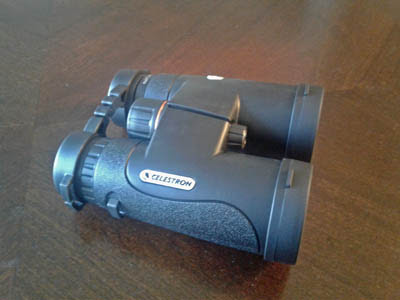 |
| New binoculars! Celestron Nature DX ED 8×42 |
Wrapping Up
The Celestron Nature DX ED 8×42 are my recommendation for the best bird watching binoculars under $200, in fact, best under $250. And these are often available for about $150!
These are, right now, the lowest priced birding binoculars with excellent ED optical glass and are waterproof and fog proof. These are perfect for your first “real” outdoor bird watching binoculars.
Strengths
- High optical quality at a budget price
- Bright, sharp, colorful at center of image with superior ED glass
- Decently wide field of view
- Long eye relief for eyeglass wearers
- Excellent close focus of 6.5 feet
Weaknesses
- The eye cups are too easy to turn and seem a bit fragile
- The focus knob takes 2 complete revolutions from close to infinity
- Soft focus toward edge of image, as typical for this price range
There are a couple of similar binoculars falling into two camps.
Those without the superior ED glass: the old model Celestron Nature DX 8×42, the Vortex Crossfire HD 8×42, and the Carson VP 8×42.
Another low-priced binocular with ED glass and great specs is the Wingspan Optics SkyView Ultra HD 8×42. It is nearly identical to the Celestron Nature DX ED 8×42. On paper, there is no obvious superiority of one over the other.
Check out the prices here. These are affiliate links. If you purchase items through these links I will earn a small commission without any added cost to you. Thank you!
Frequently Asked Questions
How do binoculars work?
Binoculars work through a clever combination of lenses and prisms to magnify distant objects and make them appear closer and clearer. Here’s a breakdown of the key principles:
Gathering Light:
- Objective Lenses: The large lenses at the front of each “barrel” are called objective lenses. They gather light from the distant object and bend it inwards (refraction). This creates a focus point where the image of the object forms.
Magnifying the Image:
- Eyepiece Lenses: After passing the focus point, the light rays travel through the smaller lenses called eyepieces. These lenses further bend the light rays, but this time outwards (divergence). This divergence creates the illusion of the object being closer and larger, essentially magnifying the image for your eyes.
Correcting Image Inversion:
- Prisms: Without any additional processing, the image formed by the objective lenses would be inverted (upside down) and reversed (left to right). To fix this, binoculars use prisms (usually Porro prisms or roof prisms) to reflect and redirect the light rays before they reach the eyepieces. This flips the image horizontally and corrects the inversion, presenting you with an upright and non-reversed view of the object.
What does 10 by 42 binoculars mean?
When you see binoculars labeled as “10×42,” it refers to two key specifications:
- Magnification: The first number, “10,” indicates the magnification power of the binoculars. In this case, it means objects will appear 10 times closer than they would to your naked eye. This can be helpful for observing distant details, like bird feathers or wildlife markings.
- Objective Lens Diameter: The second number, “42,” refers to the diameter of the objective lenses in millimeters. These are the large lenses at the front of each binocular barrel that gather light from the object you’re viewing. Larger lenses collect more light, resulting in brighter and clearer images, especially in low-light conditions.
So, in summary, 10×42 binoculars magnify objects 10 times closer and have objective lenses with a diameter of 42 millimeters. This is a popular choice for general-purpose binoculars that offer a good balance between magnification, brightness, and portability.
Why are binoculars so expensive?
Binoculars can range in price from relatively affordable to eye-wateringly expensive, and the price tag often reflects several factors that go into their design and manufacturing:
Quality of Optics:
- Lens Materials: High-quality binoculars use premium optical glass with advanced coatings. These coatings reduce glare, reflections, and chromatic aberrations, resulting in sharper, clearer, and brighter images. These materials and processes can be costly.
- Precision Grinding: The lenses in good binoculars are meticulously ground and polished to incredibly precise tolerances. This ensures accurate light transmission and focusing, crucial for optimal viewing. Such precision requires skilled labor and specialized equipment.
- Prism Technology: Different prism designs in binoculars (like Porro or roof prisms) impact image quality, weight, and complexity. More sophisticated prism designs often contribute to a higher price point.
Construction and Durability:
- Body Materials: Binoculars can be made from various materials like metal, rubberized plastic, or polycarbonate. Durable, weatherproof materials that withstand shock and harsh conditions add to the cost.
- Waterproof and Fogproof seals: Good binoculars are often sealed to be waterproof and fogproof, allowing you to use them in any weather conditions. Implementing effective seals requires meticulous engineering and adds to the production cost.
- Internal Mechanisms: Precise focusing mechanisms, eyepiece adjustments, and diopter correction features all contribute to the overall quality and price of binoculars.
Related articles:
How to adjust your binoculars and how to use them to spot more birds: How to use binoculars for bird watching
At this price point you get what you pay for. If you have a larger budget you can get better binoculars. May I suggest my Review of Nikon Monarch 7 8×42 binoculars, which I recommend as the best birding binoculars under $500.






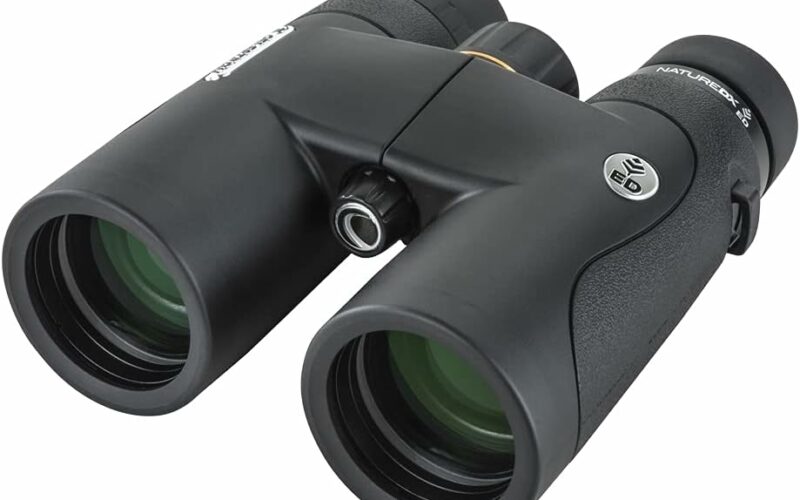

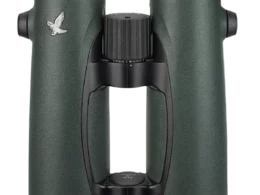

Spot on Greg. I bough them recently based on your review and I think your review is accurate. Thanks.
The image through the ED lens on these binoculars is indeed very crisp and sharp and clear and all other good adjectives. In fact all the pigeons in my backyard look like new birds to me. I had an old Olympus EXWP I from about 10 years back. They were excellent when I bought them. But now with these ED lens technology I think I stand upgraded. Haha.
Thanks again
Kili
I'm so glad you like them, Kili.
Thanks for your opinion and review.
Hi, thanks for sharing this article. Recently I was hesitating to buy Clestron Nature DX ED or Nikon PROSTAFF 7S, both are on 8×42. The price on amazon seems similar. would you recommend Nikon or Clestron of these two? Thanks.
The Nikon is a touch lighter and has slightly longer eye relief for eyeglass wearers.
The Celestron has wider field of view and focuses closer.
I haven't had the opportunity to compare them side-by-side. But I'm happy with the Celestron's I own, and don't have any hesitancy in recommending them.
Thank you! Thank you! I was wanting to understand the difference between the older celestron Nature DX 8×42 Binoculars and the "ED" version. This was perfect. I'll go ahead and get the ED version 😉
ED glass is becoming the standard, even on more inexpensive models.
Just want to point out Nature DX ED has no dielectric coating
I tried it and I agree it is a really good binoculars, especially for its price ($120 with discount now) with this quality. But I also experienced its quality problem like others, the first pair caused me headache and eyestrain. I believed it was out of collimation. Second pair is wonderful like what you reviewed. I ended up getting the Zeiss Terra Ed (used <$300) because I feel that it's more reliable in long term. Its optic quality is better than Nature DX but not a lot. If Nature DX ED has a better quality control I will definitely choose it.
My $500 Monarch 7's had quality issues. Only 3 years old and rubber eyecups expanded and fell off in summer heat. Lost the eyecups somewhere in the desert. Body armoring deteriorated, too. Peeling on one barrel.
So, I'm using the Celetron Nature DX ED as my main binoculars. They've held up great and may actually have brighter colors and sharper focus. The focus wheel works backwards from almost all other binoculars, and takes 2-1/2 turns. But otherwise they have been unexpectedly good for such a low priced binocular.
I see, I think if you're original consumer purchaser, they will fix them for you. https://www.nikonusa.com/en/nikon-store/shopping-help/warranties.page